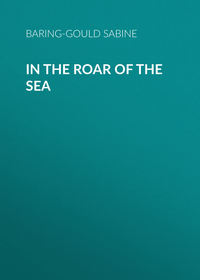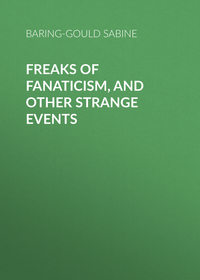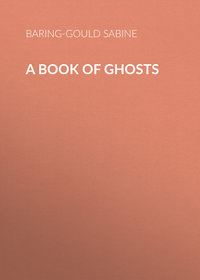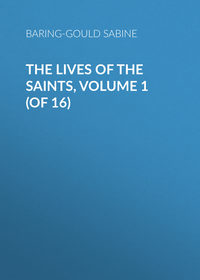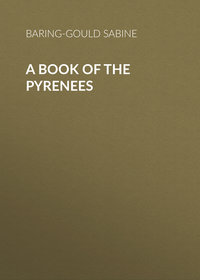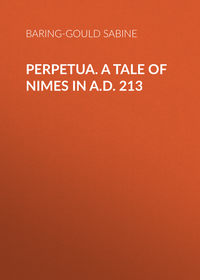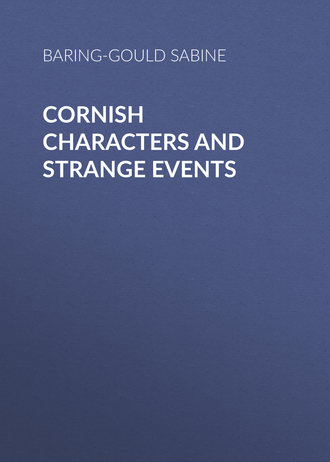 полная версия
полная версияCornish Characters and Strange Events
Lady Killigrew seems to have formed a scheme for robbing the merchant vessel and massacring the crew and the owners, and several efforts were made to induce the two merchants to quit their inn at Penryn and return on board, so that the whole of those on the vessel and the merchants might be got rid of, and not a witness left. However, this failed; Chavis and Oryo did not return to their ship.
About midnight on 7th January a boatload of men boarded the Spanish vessel and overpowered the sailors, raised the anchors, and set sail. The Spaniards were all either butchered or thrown into the sea. The ship was then taken to Ireland, where she was plundered and the spoil divided. But before this was done, two of Lady Killigrew's servants, named Kendal and Hawkins, were sent back to Arwenack with sundry bolts of Hollands and leather, as the share of Lady Killigrew, her kinswoman, Mrs. Killigrew, and the maids and servants in the house.
Lady Killigrew was highly incensed at being put off with so little, but fume as she might she could do nothing, for the ship was on its way to Ireland. What she did accordingly was to keep all that was sent on shore for herself, and distribute none of it among her household.
The two merchants now stirred, and laid formal complaint before the Commissioners for Piracy in Cornwall. Among these was Sir John Killigrew, the husband of the lady who had contrived or abetted the act. A meeting was held at Penryn, and sufficient evidence was produced to implicate Hawkins and Kendal; but this they were able to rebut by the testimony of Elizabeth Bowden, who kept a small tavern at Penryn, and who swore that up to the time that the act of piracy was committed the two men Hawkins and Kendal were drinking in her inn. The jury returned an open verdict that the ship had certainly been stolen, but by whom there was no evidence to show.
Chavis and De Oryo were not men disposed to let the matter rest thus, and having procured a safe conduct to London from the Commissioners, they proceeded thither, and laid their complaint before the higher authorities, with the result that the Earl of Bedford instructed Sir Richard Grenville and Mr. Edmund Tremayne to make a searching investigation into the affair.
As might be anticipated, this inquiry was more thorough-going and real than the other, and the truth was at last elicited from witnesses very reluctant to speak what they knew. The result arrived at was this: —
The whole plot had been contrived by Dame Killigrew, who on the Sunday in question ordered Hawkins and Kendal to board the Spaniard, along with a party of sailors and fishermen got together for the purpose. Moreover, she sent a messenger by boat to the Governor of St. Mawes Castle, to inform him that the Spanish merchants proposed to sail that night, and to request him not to hinder them from so doing. The other castle, that of Pendennis, commanding the entrance to the haven, had Sir John Killigrew as Governor, and in it all day were harboured the boarding-party destined to carry off the merchantman.
Hawkins, who was the ringleader, had been sworn to strict secrecy by Lady Killigrew, who desired to keep the whole transaction from the knowledge of her husband. The leather that fell to her share was placed in a cask and buried in the garden at Arwenack. Hawkins and Kendal were hanged at Launceston, but Lady Killigrew escaped as Hals relates. Sir John died next year; when Lady Killigrew died is not known.
On the death of the later Sir John in 1633, Arwenack passed to his nephew, as he left no issue, and that nephew, Sir Peter Killigrew, married Frances, daughter and co-heiress of Sir Roger Twysden. He had two daughters, and a son George who came to an untimely end.
He was killed in a drunken brawl in a tavern at Penryn by Walter Vincent, barrister-at-law, "who," says Hals, "was tried for his life at Launceston for the fact, and acquitted by the petty jury, through bribery and indiscreet acts and practices, as was generally said; yet this Mr. Vincent, through anguish and horror at this accident (as it was said), within two years after wasted of an extreme atrophy of his flesh and spirits, that at length at the table whereby he was sitting, in the Bishop of Exeter's palace, in the presence of divers gentlemen, he instantly fell back against the wall and died."
Frances, the eldest daughter of Sir Peter Killigrew, married Richard Erisey, and had a daughter who became the wife of John West, of Bury S. Edmunds, and by him had a daughter Frances, who married the Hon. Charles Berkeley, and through their descent the estates, or such as remained of the old family of Killigrew, passed to the Earl of Kimberley.
The history of the Killigrew family, by Martin Killigrew, was published in part by Mr. R. N. Worth in the Journal of the Royal Institution of Cornwall, Vol. III (1868-70), and the story of the seizure of the Spanish vessel by Dame Killigrew was investigated by Mr. H. M. Whitley, in the Journal, Vol. VII (1881-3).
TWO NATURALISTS IN CORNWALL
The two men of science of whom a sketch is about to be given here were neither of them Cornishmen by birth and parentage, but, inasmuch as a long stretch of the life of each was spent in the delectable duchy, and as both were well known in it and made it the principal field of their labours, they deserve a place in this collection. These two men are John Ralfs, the botanist, and George Carter Bignell, the entomologist.
John Ralfs was born September 13, 1807, at Millbrook, near Southampton. His father, Samuel Ralfs, died when he was a year old, and to his mother was entrusted his early training. From an early age he manifested a passionate love of flowers, and as he grew older an interest in chemistry. Probably on this latter account he decided on the medical profession, and whilst studying medicine he prosecuted botanical research, so that on passing his final examination the President of the Royal College of Surgeons complimented him on his botanical knowledge, and predicted that the world would one day hear a good deal of this then "beardless boy."
He married a Miss Newman, and by her had a son, but they were in every way an ill-suited pair, and after a while they agreed to part, and she went to reside in France, taking her son with her.
Fortunately for science, Ralfs' health would not stand the arduous and anxious life of a village doctor, and he threw up his profession and wandered about in the south of England, a friendless, reserved, and taciturn man, devoting all his time and attention to botany. He settled finally in Penzance, in the year 1837, and became a familiar personality in the west of Cornwall, rambling over the moors, creeping into bogs, often on hands and knees, searching for rare plants; "a terror to timid ladies, who would scuttle away like frightened rabbits at the sight of this dark, strange man hanging over some deep pool, peering with his short-sighted eyes into what was to him a paradise, and perhaps calling out aloud, forgetful that he and nature were not alone, 'I see him! I've got him!' And often he would be seen resting on a stile, weary with his wanderings, his hat and coat almost as green as the grass on one of his favourite bogs, the marks of his last fray fresh upon them, his collar disappearing, apparently, in vain search of his cravat; gazing absently into the distance, where he saw, doubtless, beautiful and rare specimens of his Algæ and Diatomaceæ."
Mr. Ralfs was never so happy as when alone; he did not care for society, least of all that of women, and grievous deafness made it difficult for him to engage in conversation. Even with men of science like himself he did not care to associate, except through written correspondence. At Penzance he was generally regarded as "a bit total," a little, perhaps not a little, off his head; but no one could have other than a kind word to say of him, for he never injured any one. Occasionally his son came from France to pay his father a visit; but such visits were brief; their tastes were not the same, and their outlook into life was different.
Mr. Ralfs wrote a good deal. He contributed to the proceedings of many learned societies, but especially the Edinburgh Botanical Society. He was the author of the botanical chapter in the Guide to Ilfracombe, and of the "Sketch of the Botany of West Penwith" in Mr. J. S. Courtney's Guide to Penzance. Mr. J. T. Blight also was assisted by him in his Week at the Land's End. He helped as well in English Botany, by Sir James E. Smith, the figures by James Sowerby. He composed, moreover, a Flora of West Cornwall that remains in MS. in the Penzance Public Library.
Late in life he formed a tender attachment for a little child, who had somehow hitched herself on to him as a companion in his rambles. "The first overtures were entirely on her own side, and it was some time before this acquaintance ripened into friendship. She was a delicate child, and her playfellow – for such he became – prescribed Fresh Air and no Lessons; and so off they would go for long country walks, much to the benefit of her health, but to the detriment of her clothes. Of the mustard poultice that sometimes these excursions rendered necessary, and which could not be endured unless he submitted to a similar infliction; of the delightful dolls' tea parties; of the fairy tales, translated solely for her amusement from the French and German; of his selections from Thackeray and Dickens, whose characters were thus made living people to her; of the wonders that awaited her on S. Valentine's Day, when, through his skilful management, twenty or thirty valentines were to arrive for her from different parts of the country; of the choice variety of sweets he purchased for her stocking at Christmas; of all this, I wish I could discourse at greater length. It is sufficient to say that this friendship, thus begun, lasted to the end of his life, and was the means of relieving to a large extent that solitude which had before surrounded him.
"On Midsummer Day, when the custom is to wear wreaths of flowers, he would give free permission to the children to pick all the flowers in his garden, on condition that they would come to him flower-crowned in the evening, when he would entertain them royally with fruit and sweetmeats. On Corpus Christi Pleasure Fair (a red-letter day for little Cornish children) he would be seen with a small crowd of boys and girls around him, whom he would treat to all the various shows, waiting patiently, until their curiosity was satisfied, outside."
One great delight of Mr. Ralfs was the naturalizing of strange plants in the neighbourhood of Penzance, amongst others the large-flowered butterwort, and very much amused was he when some local paper with a flourish of trumpets announced the discovery of the Pinguicula by a botanical tourist, and a claim put forward that it was indigenous to Cornwall.
John Ralfs died 14 July, 1890, and was buried at Penzance.
The second naturalist, Mr. George Carter Bignell, is happily still alive and in full intellectual vigour, and resides in Saltash. He is a native of Exeter, having been born in that city in 1826. He was educated at S. John's Hospital in his native town, but had to leave it at the age of twelve, when he was placed in a booking-office for receiving parcels and booking passengers for the carriers who made the "Black Lion" their head-quarters when in Exeter. These carriers came from many small towns from twenty to fifty miles away. The yard and stabling were connected with the "Black Lion" and the Commercial Inn, South Street, and opposite was the office. Mr. Bignell says: "Often have I seen these lumbering wagons with twenty magnificent horses attached to them start from the office, the driver riding a cob by the side. Very often such a wagon would be conveying gold from the ships in Falmouth to the Bank of England, and in that case the wagon was attended by a guard carrying a blunderbuss."
In this office Mr. Bignell remained till he was sixteen, and in 1842 he joined the Royal Marines at Stonehouse. He saw some foreign service, and was on board the Superb during the civil war in Spain in 1847, and was employed on the coasts of Spain and Portugal. He was in the squadron which succeeded in capturing a division of the rebel army of Count Das Anton, consisting of about three thousand men. Boats' crews put off from the ships of the squadron, and under a heavy fire from the forts boarded and captured every vessel. The prisoners were conveyed up the river Tagus to Fort S. Julian, where, after being deprived of arms and ammunition, they were safely lodged.
A guard, consisting of half the complement of marines from each ship, was placed over them, the whole body under the command of Major Stransham.
A few days after the capture it was discovered that ammunition was being surreptitiously conveyed into the fort by friends of the rebels, and investigation disclosed that a plot had been hatched to blow up the fort.
Count Das Anton pretended to be wholly ignorant of the conspiracy. The rebels were paraded, each man searched, and every nook and cranny in the fort thoroughly overhauled. A large quantity of gunpowder was found, and this was promptly wheeled to the parapets in barrows and thrown into the Tagus.
The guard placed over this large body of prisoners was small, and to overawe the prisoners all the marines from the ships were landed every evening at sunset and marched with fixed bayonets to the fort, with orders to make as much noise and clatter as they could; and then at night, when all was still, they stole silently away from the fort and returned on board. So well was the ruse practised every day that the prisoners were under the impression that they were guarded by a large body, and never suspected the truth. The time at the fort was not very pleasant to the marines on guard, as the place was filthy and literally swarmed with fleas, and their white drill suits were so covered with these detestable insects that the marines appeared to be dressed in brown instead of white clothing.
This was Mr. Bignell's only taste of active service. When the Superb was paid off he was employed in several offices in the barracks, first as commanding officer's clerk, and afterwards he was appointed to the barracks at Millbay as barrack sergeant, and he held this appointment for seven years. By the end of this time he had served twenty-two years. Throughout all this time he had been a keen and close observer of nature. From his boyhood up natural history had exercised a great attraction for him, and as he grew up, and studied, the subject became more and more interesting. During his last seven years of service he made considerable progress, for as a barrack sergeant he had little work to do, and so had plenty of time to devote to his hobby.
After being discharged he became a member of the Plymouth Institution, with the object of finding out the names of some of the insects he had captured, and was surprised to find that it had nothing like them in its collection, nor could anybody tell him what they were.
Mr. Bignell had barely retired from the service ere he was appointed Registrar of Births and Deaths for the Stonehouse district and also Poor Law Officer to the Stonehouse Board of Guardians; but his residence is in Saltash. All his spare time has for many years been given up to scientific pursuits, the branch of science to which he is most partial being entomology; but since his residence in Saltash he has been a profound student in marine flora. It is not only in the study of the known and hitherto unregistered insects that Mr. Bignell has acquired a world-wide fame; he has specially taken up the subject, hitherto almost untouched, of the parasites that live on insects.
To grasp what has been done by him an examination must be made of the entomological journals for the last forty years, for there he is generally in evidence. In the proceedings of the Entomological Society of London Mr. Bignell's name is quoted as being the discoverer of fifty-one parasites, nineteen being new to science and thirty-two new to Britain. In recognition of this work, one of the new species has been named after him Mesoleius Bignellii. The Royal Cornwall Polytechnic Society have awarded him three of their medals, a bronze one for "land and fresh water shells," a silver one for a "collection of British moths," and a second silver medal for "butterflies and moths."
In the publications of the Ray Society on the Larvæ of British Butterflies and Moths, at the end of each volume we find a list of parasites preying on these beautiful insects, "kindly prepared by Mr. G. C. Bignell, f. e.s."
One of the most extraordinary features of Mr. Bignell's work is the infinite delicacy wherewith even now at an advanced age he is able to draw and colour his specimens. The miniature painter of a beautiful girl's face a century ago did not take more pains to delineate the object of his admiring study than does Mr. Bignell to obtain a "counterfeit presentment" of some disgusting caterpillar or parasitic insect.
The hunting for specimens would be an exhausting toil were it not a labour of love. On one occasion Mr. Bignell obtained one hundred and forty-one caterpillars of a certain moth in Whitsand Bay, under Fort Tregantle. They were feeding on henbane, and as he did not know where else to get the right sort of food for them, he had to go out two or three times a week for the food, walking in all a hundred miles. But, alas for the ingratitude of the caterpillars, not a single moth rewarded all this devotion! Yet even this was outdone by a hundred and thirty-five mile walk in the dark to attempt to capture one sort of moth, which perhaps deserves to be mentioned for its elusive ways. It is called the Dasycampa rubiginea, and has to live up to its name. Plym Bridge was supposed to be its haunt, and its time of taking its walks or flutter abroad, night, and that also in midwinter. So night after night in November and December it was stalked, till one night, between the 6th and 7th December, the moth was spotted leisurely sipping honey from the flowers of the ivy growing on one of the pillars of the old gateway leading into Cann Wood between Plym Bridge and Plympton, just as the clock at Morley House was striking twelve.
A pathetic interest attaches to the large copper butterfly. This splendid species was first discovered in Wales by the celebrated botanist Hudson. It was subsequently captured in considerable numbers about Whittlesea Mere, in Huntingdonshire. Now, alas! it is extinct, and a specimen such as one possessed by Mr. Bignell is worth some pounds. The last secured was in 1847. Greedy collectors and dealers from London, after its discovery, were waiting for it, and offered the country yokels five shillings for every caterpillar secured. Now it is as extinct as the dodo and the great auk.
There would seem to be no living creature that is not a home and feeding ground for parasites; even the butterflies are infested with them, and probably these parasites also have others infinitely small that attack them.
Great fleas have little fleas upon their backs to bite 'em,And little fleas have lesser fleas – and so ad infinitum.One of the most interesting discoveries made by Mr. Bignell is that a creature like a scorpion – but all claw – that is found upon the common house-fly is not a true parasite. It likes a ride, and to do it cheap. And when a fly comes within reach, it lays hold of it with its disproportionately huge claws, clings, and has a ride, free, gratis and for nothing. When it has seen enough of the world and is tired, it lets go and drops off.
Says Mr. Bignell: "The Blossom Underwing is a moth that was very abundant on the male flowers of the great sallow on April 13th, 1866. Previously this moth was very scarce; but on this night I saw at least a thousand; they were all in pairs, and each pair occupied a flower, a sight never to be forgotten. The fine flowering scrubby oaks were swarming with the larvæ. A friend of mine who kept birds in a very large cage, seeing the abundance of the caterpillars, decided to give his birds a treat; he accordingly gathered about a pint of them, carried them home, and instead of giving the birds two or three at a time, he incautiously put the tin into the cage and removed the lid. At once the caterpillars began to escape, and the seething mass of black and yellow wriggling over the floor, crawling about the wires, so frightened the birds that it caused the death of two of three, which beat themselves against the cage in vain hope to escape from these uncanny horrors."
As may be well imagined, Mr. Bignell with his lantern stealing up the side of a hedge in the night often enough routed the poachers and sent them flying, thinking they were being watched by a policeman. On one occasion he scared an owl. "I was enjoying myself, on my knees, hunting over the contents of my net that I had used for sweeping the low foliage, to see what captures I had made. My nose and bull's-eye lantern were thrust close to the ground, to prevent anything escaping observation. In the midst of this occupation an owl swooped down to see what was up, when I turned my lantern on him, and away he flew in a mighty hurry, bringing the back of his wings together with great force, like a man clapping his hands. He was evidently in great alarm, and uttered an unearthly scream. It certainly gave me also a turn, it was so sudden."
All moths with highly pectinated antennæ, that is to say with their feelers comb-like at the extremities, have the most extraordinary power of scenting a female moth at a great distance, even two or three miles, with a favourable wind.
Mr. Bignell says: "I once had a virgin female of the Oak-egger moth, and was desirous of getting some males. I started off with the lady in a tin box, with a perforated zinc top, to give her air and allow her perfume to escape. I walked through the fields towards Milehouse to where was a turnstile; and at this spot lighted on a weary policeman resting. As it was a dull day, without any token of the sun breaking out, to attract butterflies for their usual gambols, the policeman jeeringly remarked that I had missed the right day. I replied that I thought not, and that I could collect as many as I desired, in fact, I could make them come to me. He laughed incredulously. I then took out my tin box and placed it on the wall, and, magician-like, whistled and waved my hand. The policeman stared, and thought I was befooling him. But lo, in two or three minutes one male alighted close to the box, soon followed by others, and in a quarter of an hour I had at least fifty, and so tame that I picked them up with my fingers and distributed them among about a dozen people who had gathered to see what I was about. The policeman stared with open eyes and mouth, quite satisfied that my whistle and mysterious signs in the air with my hand had called the insects to me. Satisfied with what I had got I waved again and bade the moths depart, and clapped the box in my pocket. Next day I took the empty box out with me into the country. I had several males following me, and some actually penetrated into my pocket where was the empty box, proving that the perfume still remained in it, though wholly imperceptible to myself."
On one occasion Mr. Bignell and a friend set out at night to find the beautiful moth Heliophobus hispidus, knowing its haunts, between the south side of the Plymouth citadel and the sea, where it is to be found in September or October resting on the grass.
Accordingly, each furnished with a bull's-eye lantern, they visited the locality, but it was some time before one was discerned, and that was on a blade of grass overhanging the cliff and out of reach, a sheer drop of twenty feet at least into the sea fretting and moaning below. Loath to miss it, as its eyes shone like two rubies – in fact, both saw those glistening eyes before they observed that they were in the head of the moth – they arranged that one should lie flat on his stomach, and that Mr. Bignell should sit down, dig the heels of his boots into the turf, then take his friend by the legs and thrust him over the edge of the cliff, so far as to enable him to box the moth, whilst holding the handle of his lantern between his teeth. This was done, and the Heliophobus was secured.
But, after all, it is in the direction of parasites living upon insects that Mr. Bignell has made the greatest research. He is the possessor of a unique collection of the parasites that live on the aphis, and also of the hyper-parasite which preys upon that parasite. The life-history of this insect was unknown till Mr. Bignell detected a hyper-parasite pierce the aphis which was itself a parasite. The specimen was secured, and from it was bred the hyper-parasite itself.


